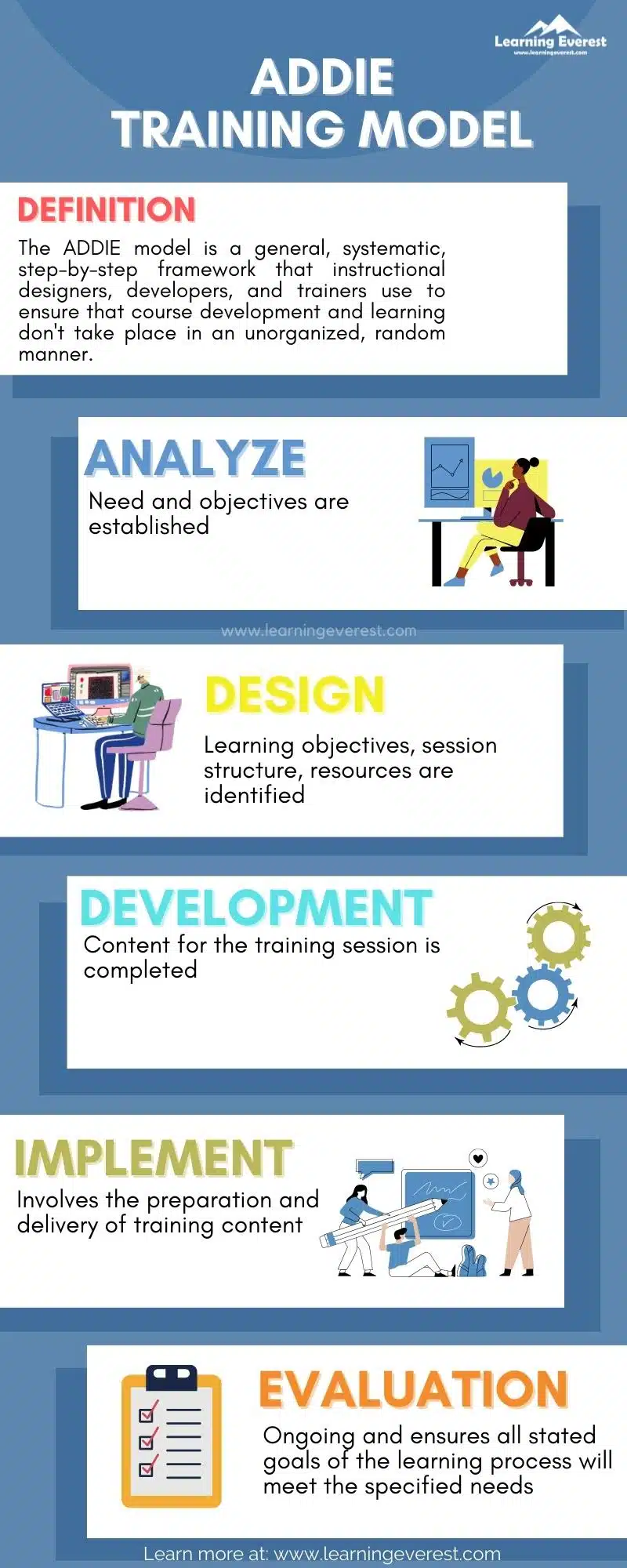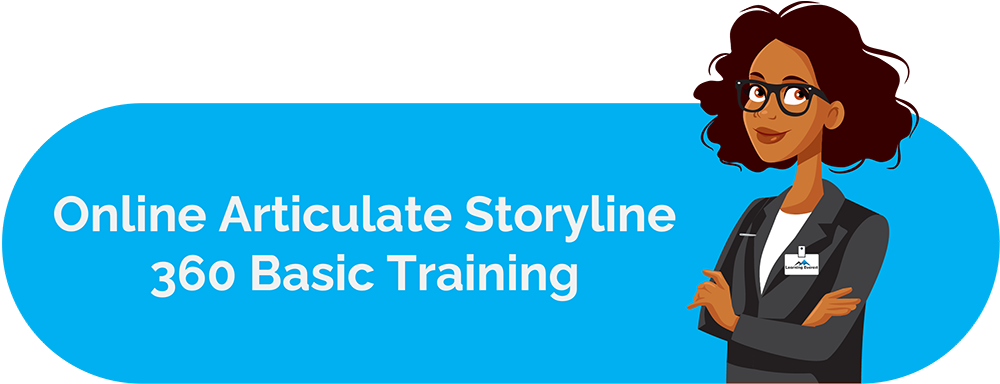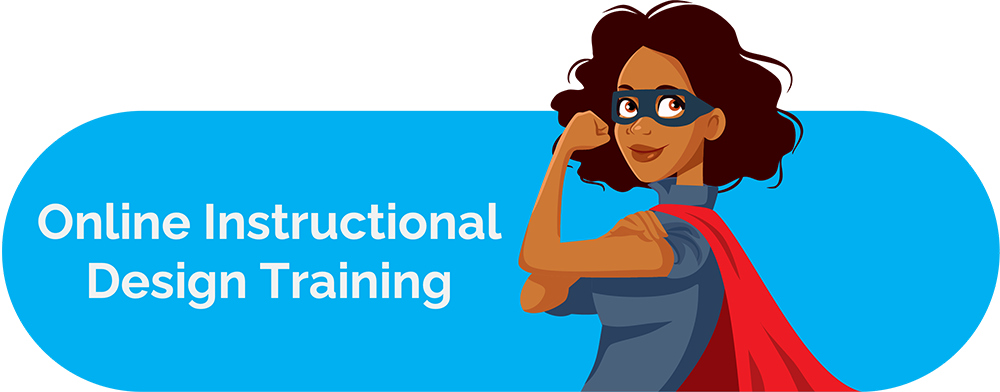Table of Contents
What is an ADDIE Training Model?
In an e-learning process, instructional designing enables consistency-across various courses and modules, developers, instructors, and designers. It pays attention to effective ways to communicate the content of different types. There are many instructional design models. One such is ADDIE. ADDIE is a well-known Instructional System Design (ISD) model. The ADDIE training model of instructional designing is a general, systematic, step-by-step framework that instructional designers, developers, and trainers use to ensure that course development and learning do not take place in an unorganized, random manner. Its design is to provide that the learners will achieve the goal of the course.
There are five stages in the ADDIE instructional design model: analysis, design, development, implementation, and evaluation. Therefore, ADDIE is more of a process that helps in designing e-learning. As designers of e-learning focus on a learner-centric approach, a designer needs to be familiar with the requirements in each phase. One phase’s final output serves as the first output of the subsequent phase in an ADDIE training model. The decisions made in each stage ultimately will affect whether the system is learner-centric.
ADDIE Training Model Phase 1: Analyze
The very first stage of the ADDIE training model of instructional designing is the analysis stage. It is the data gathering section of instructional design. Here instructional designers try to accumulate every information they can get. To ensure the effectiveness of the design, instructional designers must collect every bit of data possible at this point because it will be used across the entire system. There are a few questions to ask at this stage:
- Why do we need to design this content for e-learning?
- Who are the audience and their characteristics?
- What and how to teach?
- What types of learning constraints exist?
- What are the delivery options?
- What are the online pedagogical considerations?
- What is the timeline for project completion?
By estimating the potential learners by asking all the questions, the instructional designers initiate the e-learning process. The recognition of the target audience helps the latter process to run effortlessly.
ADDIE Training Model Phase 2: Design
The next phase of the ADDIE training model of instructional design is the design phase, where instructors dive into designing the materials. The design phase of instructional systems is when the project’s layout is created, complete with all necessary specifications by instructional designers.
Instructional designers create the course material, define the objectives, and finish the design plan during this phase. Some of the questions asked in this stage include:
- What are the learning objectives?
- What resources and pedagogical strategies to use?
- How do you structure the content of the learning material?
- How do learners access the understanding?
These questions specify the learning objectives, activities, and assessment. Instructional designers choose methods, strategies, and media based on that. These are the steps used for the design phase:
- Documenting the design strategy
- Application of the instructional strategies
- Creating storyboards
- Designing the user interface and user experience
- Prototype creation
- Applying visual design (graphic design)
ADDIE Training Model Phase 3: Development
In the development phase, the actual production of the materials begins, i.e., the storyboard and the coding. Texts and multimedia materials are prepared and collected. So, at this stage, most non-designers start to see progress.
Everything is carried from design to deliverable, including lesson notes and virtual reality. It is wise to do pilot testing to ensure that deliverables do not have to be redeveloped. So, at this stage, these questions are needed to be asked:
- Are the materials addressing the learning objectives?
- Is the subject content in the materials correct?
ADDIE Training Model Phase 4: Implementation
The implementation stage refers to the delivery of the instruction. In the implementation stage of instructional design, instructors train the users of the materials, perhaps by creating a short video and inserting it into the e-learning on how to use the materials, and make sure learners have access to the materials, equipped infrastructures, and so on. Some of the questions asked in this stage include:
- Are the strategies working as planned?
- Have all technological glitches been sorted out?
- Are the learners having difficulty with the material?
At the implementation stage, the design plan meets the learner, and the content is delivered. Evaluation is used to determine how well project facilitators and learners are meeting their objectives.
ADDIE Training Model Phase 5: Evaluate
Evaluation doesn’t deserve to be listed last this model, given that it occurs throughout and surrounds the instructional design process. The evaluation phase is an ever-going process that ensures all stated goals of the learning process will meet the specified needs. This phase is therefore needed to be done after every phase. It is called Formative evaluation. Each level of the ADDIE training model includes formative evaluation. But after finishing all the phases at the end, the instructional designers do a Summative evaluation. Summative evaluation includes tests created for criterion-related referenced items that are particular to a given domain and offers chances for feedback. At this stage, to generate a well-resourced training model, the instructional designer tries to,
- Collect strategies.
- Analyze data.
- Create final data.
Advantages of the ADDIE Training Model
The capacity to swiftly and effectively develop projects is one of the many benefits of having an instructional system like ADDIE. Here are some advantages of the ADDIE training model:
- ADDIE training model saves time and is cost-effective. With its linear structural approach, instructional designers find the ADDIE model beneficial for creating e-learning.
- It promotes effective learning. The ADDIE training model is learner-centric. It makes sure that the learners achieve their full potential through the e-learning experience.
- This system has a systematic learning approach that helps to design an e-learning module precisely.
- ADDIE training model uses dynamic, flexible, practical training and performance support tools to generate a well-resourced training model.
- The use of rapid prototyping makes it an effective structure for e-learning for learners.
- It offers its users a linear approach to designing e-learning.
- ADDIE training model provides the users with continual formative feedback that enriches the project’s overall outcome.
Disadvantages of the ADDIE Training Model
With the advantages, the ADDIE instructional design model can also have some downsides. Here are some disadvantages of this model:
- The linear structure of the ADDIE training model makes the model rigid and inflexible at times.
- The stages included in an ADDIE training model can be time-consuming, with multiple evaluating stages.
- The linear structure of the model makes incorporating changes a bit costly. Therefore, it affects the final project.
- Since one phase’s final output serves as the first output of the subsequent phase, the ADDIE model may be challenging to implement if there are material shortcomings.
- It does not identify the new behavioral outcomes; therefore, the ADDIE training model remains very structural.
Infographics
Conclusion
To summarize, instructional design is a systematic framework that guides us in the whole process of designing e-learning, where the focus is on the learners and learning goals. Using the ADDIE training model systematically actually helps achieve the desired qualitative measures of an e-learning system. Through it comes with certain drawbacks, the ADDIE model is an iterative structural process. It has a lot of research-based strategies, which are perfectly suitable for designing e-learning.
Frequently Asked Questions (FAQs)
What is the ADDIE training model?
ADDIE is a well-known Instructional System Design (ISD) model. The ADDIE model is a general, systematic, step-by-step framework that instructional designers, developers, and trainers use to ensure that course development and learning don’t take place in an unorganized, random manner.
How many steps are in the ADDIE process?
The ADDIE training model of instructional design has five simple stages.
What are the five stages of the ADDIE model?
There are five stages of the ADDIE training model of instructional design: Analysis, Design, Development, Implementation, and Evaluation.
Why is the ADDIE model important?
The ADDIE training model is a general, systematic, step-by-step framework that instructional designers, developers, and trainers use to ensure that course development and learning don’t take place in an unorganized, random manner. Its design is to provide that the learners will achieve the goal of the course.






